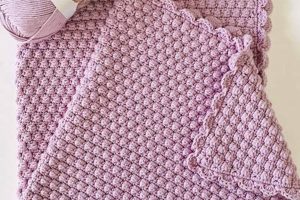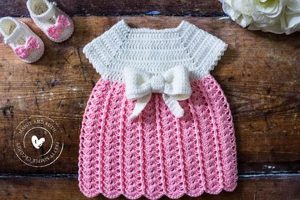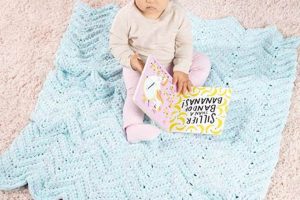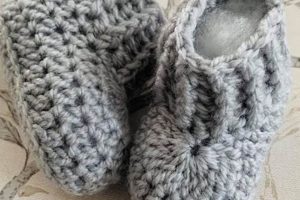The creation of soft coverings for infants frequently involves the selection and implementation of established designs coupled with the manual joining of fabric pieces. These designs, which guide the construction and embellishment of the covering, vary in complexity and style, catering to diverse aesthetic preferences and skill levels. The process typically incorporates methods like straight stitching, applique, and quilting to assemble the materials.
Handmade infant coverings offer advantages beyond mere functionality. They present opportunities for personalized expression, allowing for the incorporation of unique colors, motifs, and textures. Furthermore, constructing such items can provide a fulfilling creative outlet. Historically, these items have served not only as practical necessities but also as treasured heirlooms, imbued with sentimental value and passed down through generations.
Subsequent discussion will address various design options, suitable fabric choices, and essential techniques employed in the crafting of these textiles for newborns and infants. Specific attention will be given to selecting materials safe for delicate skin and applying methods that ensure durability and ease of care.
Guidance for Infant Covering Construction
The following guidelines are intended to facilitate the efficient and effective production of safe and durable coverings for infants, achieved through carefully selected designs and proper assembly methods.
Tip 1: Fabric Selection is Paramount: Prioritize natural, breathable fabrics such as cotton or muslin. These materials minimize the risk of skin irritation and allow for adequate airflow, crucial for infant comfort and safety. Pre-washing all fabrics before commencing reduces shrinkage and removes potential irritants.
Tip 2: Opt for Simple Designs: Intricate designs with embellishments, such as buttons or ribbons, pose a potential choking hazard. Choose straightforward patterns that minimize the risk of detachment and ingestion. Securely stitched edges are essential.
Tip 3: Seam Reinforcement is Critical: Repeated washing and handling can weaken seams. Employ a durable stitch, such as a backstitch or reinforced straight stitch, to ensure seams withstand frequent use. Consider serging or zigzagging raw edges to prevent fraying.
Tip 4: Accurate Pattern Cutting Improves Outcome: Precise cutting along the designated pattern lines is vital for achieving the intended size and shape. Utilize sharp scissors or a rotary cutter to ensure clean edges, contributing to a more professional and uniform final product.
Tip 5: Consider Blanket Weight and Size: Overly large or heavy coverings may pose a suffocation risk. Adhere to recommended size guidelines for infant coverings, ensuring the finished product is appropriately sized for the intended age group.
Tip 6: Implement Proper Washing and Care Procedures: Provide clear washing instructions to the recipient. Advise washing in cold water with a gentle detergent and tumble drying on a low setting or air drying to maintain fabric integrity and prevent damage.
Implementing these measures contributes to the creation of a safe, comfortable, and long-lasting item, suitable for daily use by infants and young children. Careful planning and meticulous execution are fundamental to achieving a satisfactory result.
The subsequent sections of this discourse will examine diverse design variations and offer insights into troubleshooting common challenges encountered during the construction process.
1. Fabric Softness
The tactile property of fabric significantly influences its suitability for infant coverings. Garments and textiles in close contact with a newborn’s skin must exhibit exceptional gentleness to prevent irritation and discomfort. Therefore, material softness is a paramount consideration during the design and construction of these items.
- Minimizing Skin Irritation
Infant skin possesses heightened sensitivity compared to that of adults, rendering it more susceptible to abrasion and allergic reactions. Fabrics lacking sufficient softness may cause chafing, leading to discomfort and potential skin damage. The selection of materials like brushed cotton, microfleece, or bamboo blends mitigates this risk, providing a smooth and non-irritating surface.
- Enhancing Comfort and Security
A soft covering contributes to an infant’s sense of comfort and security. The gentle texture mimics the feeling of being held, which can promote relaxation and improved sleep patterns. Selecting fabrics known for their plushness, such as double gauze or minky fabric, can enhance this effect.
- Impact on Overall Blanket Quality
The perceived quality of a handmade infant covering is directly linked to the fabric’s softness. A well-constructed item crafted from a premium, soft material exudes a sense of luxury and care, increasing its value and appeal. Conversely, a poorly chosen fabric, regardless of construction quality, can diminish the overall impression.
- Durability and Long-Term Softness Retention
While initial softness is crucial, the ability of a fabric to retain its gentle texture through repeated washing cycles is equally important. Some materials become rougher or lose their suppleness over time, negating the initial comfort benefits. Opting for pre-shrunk and durable fabrics, coupled with proper washing techniques (e.g., using gentle detergents and avoiding high heat), ensures long-lasting softness.
The selection of appropriately soft fabrics during the design and creation directly impacts the comfort, safety, and overall quality of the finished article. Prioritizing this aspect ensures a positive tactile experience for the infant and enhances the perceived value of the carefully constructed textile.
2. Seam Durability
Seam integrity is a crucial factor in the longevity and safety of infant coverings created through established designs. The method by which fabric pieces are joined directly affects the item’s ability to withstand regular use, washing, and potential stress, making it a central element in the creation process.
- Stitch Selection and Fabric Compatibility
The type of stitch employed significantly impacts seam strength. A straight stitch, while adequate for some applications, may not provide sufficient resilience for items subjected to frequent laundering. More robust options, such as a backstitch or reinforced straight stitch, offer enhanced security. Furthermore, the chosen stitch must be compatible with the fabric’s weight and weave. A delicate fabric requires a finer stitch to prevent puckering or tearing, while a heavier fabric necessitates a stronger stitch to ensure a secure bond.
- Reinforcement Techniques for High-Stress Areas
Specific areas of an infant covering, such as corners and edges, are subject to increased stress. Implementing reinforcement techniques in these regions is essential to prevent seam failure. Methods like double stitching, the addition of binding, or the application of fusible interfacing provide added stability and extend the item’s lifespan. These techniques distribute stress more evenly, reducing the likelihood of tears or unraveling.
- Thread Quality and Fiber Content
The thread used in seam construction plays a vital role in determining overall durability. High-quality threads, composed of strong fibers such as polyester or cotton-wrapped polyester, offer superior resistance to breakage and abrasion. The thread’s fiber content should also complement the fabric being used. For instance, a cotton thread is often preferred for cotton fabrics, as it shrinks at a similar rate, minimizing puckering. The selection of appropriate thread gauge is also crucial; a thread that is too thin may break easily, while a thread that is too thick may damage the fabric.
- Seam Finishing Methods and Fray Prevention
Proper seam finishing is necessary to prevent fraying and unraveling, which can compromise the integrity of the joined fabric. Techniques like serging, zigzag stitching, or the use of bias tape encase raw edges, preventing loose threads from pulling apart. These methods not only enhance the seam’s appearance but also contribute significantly to its longevity. Overlock stitching, in particular, creates a durable and professional-looking finish that is highly resistant to fraying.
The careful consideration and implementation of these seam durability elements are essential for creating infant coverings that are not only aesthetically pleasing but also capable of withstanding the rigors of daily use and repeated cleaning. A focus on robust seam construction translates to a safer and more enduring product, ensuring peace of mind for caregivers and comfort for the infant.
3. Size Appropriateness
The dimension of infant coverings, a crucial element in their safe and effective utilization, is intrinsically linked to design selection and implementation. Deviation from established size guidelines presents potential hazards, underscoring the importance of adhering to appropriate dimensions when constructing these items. Excessive size increases the risk of suffocation or entanglement, while insufficient size diminishes the blanket’s utility in providing warmth and comfort.
The connection between intended dimensions and design selection manifests in several ways. Patterns specifically designed for infant coverings typically incorporate pre-calculated measurements to ensure compliance with safety standards. For example, a pattern intended for a receiving blanket will specify dimensions that are smaller than those for a toddler-sized quilt. Furthermore, design elements, such as borders or embellishments, must be scaled appropriately to maintain proportional integrity and prevent undue bulk. An overly large border on a small blanket, for instance, could create a potential choking hazard if it detaches. In real-world applications, neglecting size considerations has resulted in product recalls and injuries, reinforcing the practical significance of this aspect. Manufacturers and independent artisans alike must prioritize dimensional accuracy to mitigate potential risks and ensure the safety and well-being of infants. The implementation of quality control measures, including accurate measurements and thorough inspections, is essential to upholding these standards.
Accurate dimensions are essential for infant coverings due to safety and functional importance, therefore, size is not merely an aesthetic aspect but rather a critical parameter governing its suitability for use. The selection and execution directly influence whether the item is safe, effective, and meets the unique needs of the intended recipient. A precise application of appropriate dimensions contributes significantly to the creation of a useful and secure product.
4. Design Simplicity
Within the context of infant covering construction, design simplicity assumes significance due to its direct correlation with safety and functionality. Intricate patterns, involving elaborate embellishments or complex construction techniques, often introduce potential hazards. Small, detachable components, such as buttons, ribbons, or appliqus, present a choking risk to infants. Complex quilting designs, while aesthetically appealing, can create uneven surfaces that may cause discomfort or pressure points. Therefore, prioritizing straightforward designs in infant covering patterns reduces the likelihood of these complications. The effect of simplified patterns translates to easier construction, reducing manufacturing costs, and ensures a more durable and easily maintained final product. A common example is the use of a basic square or rectangular blanket with simple, securely stitched edges, devoid of extraneous adornments.
The application of design simplicity extends beyond mere aesthetics. It directly impacts the washability and longevity of the covering. Elaborate designs often require specialized cleaning procedures, increasing the likelihood of damage or shrinkage. Simplified designs, conversely, allow for machine washing and drying, enhancing convenience for caregivers. A practical illustration of this principle is the prevalent use of plain, unpatterned fleece or cotton fabrics for infant coverings. These materials are easily cleaned and maintain their structural integrity through repeated wash cycles. In instances where embellishments are desired, they are typically integrated using techniques that prioritize secure attachment, such as embroidered designs that are flush with the fabric surface, rather than applied elements.
In conclusion, design simplicity, a cornerstone of effective infant covering construction, is not merely a stylistic choice but a pragmatic consideration driven by safety and practicality. Prioritizing simple patterns, secure construction techniques, and easily maintainable materials minimizes potential risks and enhances the overall utility of the finished product. While complex designs may offer visual appeal, the inherent risks associated with such complexity often outweigh the aesthetic benefits. The challenges associated with intricate designs underscore the need for a balanced approach that prioritizes infant safety and caregiver convenience above all else.
5. Washability
The characteristic of washability holds paramount importance within the domain of infant covering design and construction. Given the frequency with which these items are subjected to soiling, ease of cleaning and maintenance is a primary consideration during the selection of designs and materials.
- Fabric Selection and Wash Cycle Compatibility
The choice of fabric directly influences the appropriate wash cycle. Natural fibers, such as cotton or bamboo, generally withstand repeated machine washing, while more delicate materials, like certain types of wool or silk blends, may require hand washing or gentle cycles. Pattern instructions should explicitly specify appropriate wash cycles to prevent damage to the finished item and ensure long-term usability. Ignoring fabric care labels can lead to shrinkage, color fading, or distortion of the material.
- Seam Construction and Detergent Resistance
Seam construction plays a critical role in maintaining structural integrity through repeated washing. Securely stitched seams, reinforced corners, and finished edges are essential to prevent unraveling or fraying. The thread used should also be resistant to degradation from detergents. Inferior thread can weaken with each wash, compromising the seam’s integrity. Design choices, such as the inclusion of appliqus or embellishments, must consider their washability. Elements that are not securely attached may detach during laundering, posing a potential choking hazard.
- Colorfastness and Dye Stability
The colorfastness of fabrics used in infant coverings is crucial to prevent dye bleeding or fading during washing. Fabrics should be pre-washed to remove excess dye and minimize the risk of color transfer. The selection of high-quality dyes and appropriate dyeing processes contributes to the long-term vibrancy of the colors. Design considerations, such as color blocking or intricate patterns, must account for the potential for dye migration, which can distort the intended aesthetic.
- Drying Methods and Shrinkage Control
The method used to dry infant coverings significantly impacts their shape and size. Machine drying at high temperatures can cause shrinkage, particularly in natural fibers. Air drying or tumble drying on low heat is preferable to minimize shrinkage and preserve the fabric’s texture. Design patterns should factor in potential shrinkage rates to ensure the finished item maintains its intended dimensions after washing. Pre-shrinking fabrics before cutting and sewing is a proactive measure to mitigate this issue.
The intersection of washability and the creation of these essential textiles is a complex interplay of material science, construction techniques, and design considerations. Careful attention to these facets ensures that the finished product not only meets aesthetic expectations but also provides a safe, durable, and easily maintainable item for infant care. A failure to address washability effectively compromises the utility and longevity of the infant covering.
6. Edge Finishing
The treatment of raw fabric borders, a fundamental aspect of textile construction, holds particular significance in the context of crafting infant coverings. Proper edge finishing ensures durability, prevents fraying, and contributes to the overall safety and aesthetic appeal of the item. The selected technique must harmonize with the chosen fabric, design, and intended use to optimize the final product.
- Binding Application and Material Compatibility
The attachment of fabric binding to the perimeter of an infant covering provides both reinforcement and visual appeal. Binding materials, such as cotton tape, bias tape, or self-fabric strips, should be compatible with the primary fabric in terms of weight, texture, and washability. Improper material selection can lead to puckering, distortion, or uneven wear. For example, using a heavy binding on a lightweight fabric may cause the edge to ripple, while using a non-washable binding on a washable blanket compromises its practicality. In instances where delicate fabrics are employed, bias binding cut from the same material provides a cohesive and gentle finish.
- Serging and Overlock Stitch Techniques
Serging, or overlock stitching, encases raw edges with thread, preventing fraying and creating a clean, professional finish. This technique is particularly well-suited for fabrics that are prone to unraveling, such as fleece or loosely woven cotton. However, the serged edge may not be as soft or aesthetically pleasing as other finishing methods, and therefore, consideration must be given to the blanket’s intended use and design. For instance, a serged edge may be acceptable for a utilitarian blanket but less desirable for a decorative heirloom item.
- Hemming and Folded Edge Construction
Folding and hemming raw edges provide a simple and effective means of creating a clean, durable border. This technique involves folding the fabric edge over itself, securing it with a straight stitch or decorative stitch. Hemming is appropriate for a wide range of fabrics and designs, offering a versatile and cost-effective solution. However, multiple folds may add bulk to the edge, particularly with heavier fabrics. The width of the hem should be proportionate to the size and weight of the blanket; a narrow hem may not provide sufficient reinforcement, while an overly wide hem can create an unwieldy border.
- Decorative Stitching and Edge Embellishment
Beyond functional considerations, edge finishing offers opportunities for decorative embellishment. Decorative stitches, such as blanket stitches or scalloped edges, can add visual interest and enhance the blanket’s aesthetic appeal. However, embellishments must be carefully considered to ensure they do not compromise safety or durability. Protruding elements, such as fringe or tassels, may pose a choking hazard or become easily entangled. Securely attached, low-profile decorative stitches are preferable for infant coverings.
The diverse methodologies available for edge finishing in textiles necessitate a comprehensive understanding of material properties, construction techniques, and safety considerations. In the context of infant coverings, the appropriate selection and execution of edge finishing techniques are paramount to ensuring a durable, safe, and aesthetically pleasing final product. An analysis of real-world application will illustrate how the edge finishing process influences and enhances the overall item.
7. Safety Considerations
The relationship between safety considerations and the crafting of textiles for infants is direct and consequential. Established designs intended for infant coverings must incorporate safety protocols at every stage, from initial design conception to final assembly. Failure to prioritize safety may result in hazards such as suffocation, strangulation, or choking. The design and creation of such items, therefore, demand a meticulous approach to minimize potential harm.
A primary safety concern revolves around the selection of appropriate materials. Fabrics must be breathable to mitigate the risk of suffocation. Avoidance of loose weaves or excessively thick materials is crucial. Similarly, the thread utilized in seam construction must be robust to prevent unraveling, which could lead to entanglement. Real-world examples include product recalls due to the use of loosely woven fabrics and instances of infant injury resulting from detached embellishments. The implementation of stringent testing protocols, such as those mandated by regulatory agencies, helps to ensure that finished products meet established safety standards. Specific attributes, such as flame retardancy and the absence of harmful chemicals, are critical for safeguarding infant well-being. The practical significance of these considerations is reflected in reduced rates of injury and improved consumer confidence in the safety of infant products.
In summary, the integration of safety considerations into design patterns for textiles is not merely a regulatory requirement but a fundamental ethical obligation. Challenges persist in balancing aesthetic appeal with safety, particularly in the context of handmade or custom-designed items. A comprehensive understanding of potential hazards, coupled with a commitment to utilizing safe materials and construction techniques, is essential for ensuring the well-being of infants. Future advancements in textile technology and safety standards will likely further refine this interconnected relationship. The key takeaway is that safety must be the paramount concern.
Frequently Asked Questions Regarding Infant Covering Designs and Construction
The following section addresses common inquiries and misconceptions pertaining to the creation of handmade textiles for infants. The information presented is intended to provide clarity and guidance for those engaged in this activity.
Question 1: Are elaborate designs safe for infant coverings?
Elaborate designs featuring small, detachable components such as buttons, ribbons, or appliqus pose a potential choking hazard. Simplified designs, devoid of such embellishments, are generally recommended to minimize the risk of ingestion.
Question 2: What fabric types are most suitable for crafting infant coverings?
Natural, breathable fabrics, such as cotton, muslin, or bamboo blends, are preferable due to their softness and reduced potential for causing skin irritation. These materials also allow for adequate airflow, minimizing the risk of overheating.
Question 3: How frequently should infant coverings be washed?
Infant coverings should be washed frequently, ideally after each use or when visibly soiled. Regular laundering helps to remove potential allergens and bacteria, maintaining a hygienic environment for the infant.
Question 4: What stitch type offers the most durable seam for infant coverings?
A reinforced straight stitch or backstitch provides enhanced seam durability compared to a standard straight stitch. These techniques offer greater resistance to stress and repeated washing, ensuring the longevity of the item.
Question 5: Is it necessary to pre-wash fabrics before constructing infant coverings?
Pre-washing fabrics is highly recommended to minimize shrinkage and remove any residual chemicals or dyes that may cause skin irritation. This step also helps to ensure accurate sizing of the finished product.
Question 6: What are the recommended dimensions for an infant receiving blanket?
A common size for an infant receiving blanket is approximately 30 inches by 30 inches. This size provides adequate coverage without being excessively large, reducing the risk of entanglement or suffocation. However, it’s essential to verify dimensions against appropriate safety standards.
In summary, careful attention to design simplicity, fabric selection, seam construction, and washing procedures is crucial for creating safe and durable infant coverings. Adherence to these guidelines promotes infant well-being and ensures the longevity of the finished product.
Subsequent sections will address troubleshooting common challenges encountered during the construction process and provide resources for further learning.
Conclusion
The examination of “baby blanket patterns sewing” has underscored the necessity for meticulous attention to detail in the design and execution of infant coverings. Safety, durability, and practicality remain paramount considerations, demanding a commitment to informed material selection, robust construction techniques, and adherence to established safety guidelines. The potential consequences of neglecting these factors necessitate a serious approach to the craft.
Continued diligence in research and application is essential for advancing the safety and functionality of handmade infant textiles. A heightened awareness of evolving safety standards and innovative construction methods will contribute to the creation of items that offer both comfort and security to infants. The commitment to excellence in this domain serves as a testament to the dedication of artisans and manufacturers in safeguarding the well-being of the most vulnerable population. The legacy of “baby blanket patterns sewing” should be one of innovation, quality, and unwavering focus on infant safety.







